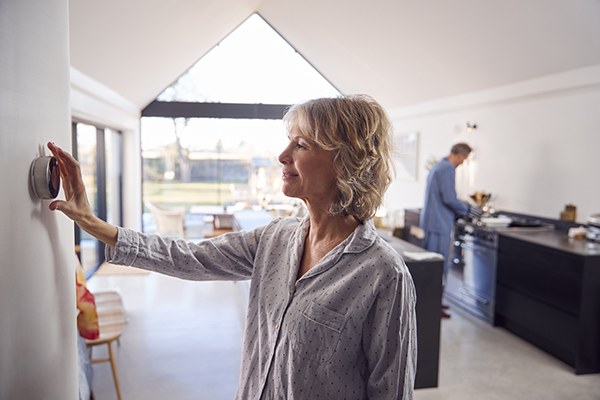Updated August 8, 2023
The thermostat in your home provides control over air conditioning, heating and ventilation and perhaps even more. Thermostats have evolved at a fast pace over the last couple of decades. Smart thermostats are more accessible and affordable than ever, and organizations like the EPA recommend them as a way of minimizing your energy usage and costs, so you ventured to your local home improvement store and picked out a model you like. Now, you’ve returned home and are left with the prospect of trying to figure out how to connect it. Generally, the process is rather simple, but this guide provides the pointers that should help you overcome any hurdles.

Remove the Old Thermostat Faceplate
You need to inspect the old thermostat to see how it is wired and eventually remove the entire unit from the wall. That requires removing the faceplate. This step is usually rather straightforward but can be tricky if you’ve never done it before. Most faceplates just snap on, so apply gentle pressure in the lower righthand corner until you here the click. Then, remove the faceplate fully. Some faceplates have a screw. If you apply pressure and it feels like the plastic may snap, locate the screw and remove it with the appropriate screwdriver first.
Inspect the Wiring
With the faceplate now removed, you can inspect the old wiring and compare it to the wiring of your newly purchased thermostat. Thermostat wiring hasn’t changed much over the years so there shouldn’t be any surprises. The wire for your AC should be red and may be labeled with the letter C. The yellow wire is for the air compressor, and the green wire for the fan. If you have a heat pump, the wire will be orange. For other heating, the wire will be white, or it will be red and labeled with the letter H.
You should also have a blue wire, which is called the common wire and often shortened to c-wire. This wire is important to the function of programmable thermostats and smart thermostats. If you have an older home, there is a chance you lack a C-wire and need to have a technician out to correct that. However, if you don’t see a C-wire, check behind the backplate first. Even though older homes often didn’t use a C-wire, it was common to have them, and technicians would often tuck them out of sight in order to avoid confusion.
Prep for Installation
Now that you know how everything matches up, you’re ready to proceed. Turn your HVAC system off and wait for everything to come to a stop. Flip the HVAC breaker to the off position. Thermostats carry low voltages and thus don’t present serious risk of electrocution, but it’s better to be safe. Label all of the existing wires. This may not be necessary if everything is exactly as described above. However, if there is any chance for confusion later, this step can save you a lot of hassle. Finally, unscrew the backplate and remove it from the wall.

Install the New Thermostat
Before you begin, position the new backplate as needed and then tape the existing wires to the wall so that there’s no risk of them falling through the hole in the wall. You can now position the backplate in place. Use a level to ensure that it is mounted correctly before screwing it secure. Connect the house wires to the wires of the new thermostat. You can follow the guide above, but you should first read the thermostat manual and adhere to any unit-specific notes required. Double-check all connections.
Finalizing the Installation
Place the faceplate on the unit. Flip the breaker to the on position. Turn on your AC unit. Most smart thermostats and even many newer programmable thermostats offer Wi-Fi support. This connection is usually automatic, but if not, check the manual for instructions. Once connected, your first step should be to change the password for your thermostat. You can now configure it and set up apps.
Your Local AC Experts
Have a new thermostat to connect but don’t want to do it yourself? Let Weather Masters Corp. in Frederick do it! In addition to installing and configuring thermostats, we provide a full range of air conditioning installation, maintenance and repair services. We’ve even earned the Best of HomeAdvisor award and we’re a Lennox Premier Dealer. Call us today to learn more about our services or to schedule an on-site consultation.
